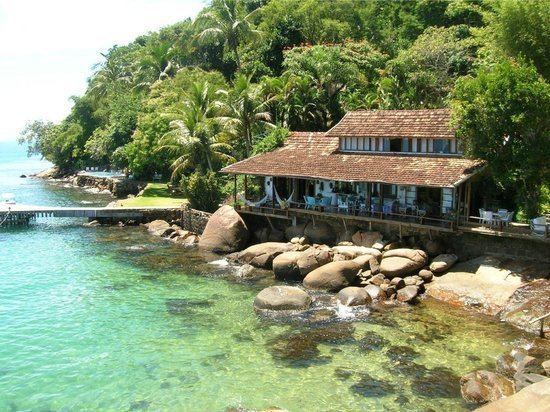Highest point Pico da Pedra D'Água Population ~5000 (2014) | Highest elevation 1,031 m (3,383 ft) Area 193 km² | |
 | ||
Points of interest Vila do Abraão, Aventureiro, Cachoeira Da Feiticeira, Praia de Lopes Mendes, Praia de Japariz Similar Fernando de Noronha, Lagoa Azul, Pico do Papagaio, Praia de Lopes Mendes, Cachoeira Da Feiticeira | ||
Ilha grande two days on brazil s paradise island gopro
Ilha Grande ([ˈiʎɐ ˈɡɾɐ̃dʒi] "Big Island") is an island located off the coast of Rio de Janeiro state, Brazil. The island, which is part of the municipality of Angra dos Reis, remains largely undeveloped. For almost a century it was closed by the Brazilian government to free movement or settlement because it first housed a leper colony and then a top-security prison. Cândido Mendes high-security prison housed some of the most dangerous prisoners within the Brazilian penal system. It was closed in 1994. The largest village on the island is called Vila do Abraão with approximately 1900 inhabitants.
Contents
- Ilha grande two days on brazil s paradise island gopro
- Map of Ilha Grande State of Rio de Janeiro Brazil
- Vlog 1 2 moroccan gringos trip in ilha grande rio de janeiro brazil 2015 gopro hero 3 black
- Fauna floraEdit
- Tourism industryEdit
- References
Map of Ilha Grande, State of Rio de Janeiro, Brazil
The island, which is 193 km2 (75 sq mi) in area, is now a popular tourist destination that is noted for its scenic beauty, unspoilt tropical beaches, luxuriant vegetation and rugged landscape. The highest point is the 1,031 m (3,383 ft) Pico da Pedra D'Água. Most of its territory is within the Ilha Grande State Park. The remainder of the island is subject to stringent development restrictions.
Vlog 1 2 moroccan gringos trip in ilha grande rio de janeiro brazil 2015 gopro hero 3 black
Fauna & floraEdit
Ilha Grande is one of the most pristine remnants of Brazil's Atlantic rainforest making it one of the richest ecosystems in the world. As a hotspot for biodiversity and conservation, it holds some of the largest remaining populations of many endangered species, including the red-ruffed fruitcrow (Pyroderus scutatus), the brown howler monkey (Alouatta fusca), the maned sloth (Bradypus torquatus) the red-browed amazon parrot (Amazona rhodocorytha), and the broad-snouted caiman (Caiman latirostris). The seas around the island, which are also protected, feature a unique convergence of tropical, subtropical, and temperate-zone marine life, and may be the only waters in the world where it is possible to see corals and tropical fish along with Magellanic penguins and southern right whales.
The islands is contained within the 12,400 hectares (31,000 acres) Tamoios Environmental Protection Area (APA), created in 1982. The island (and APA) contains the Aventureiro Sustainable Development Reserve, created in 2014 from the former Aventureiro Marine State Park, which was integrated with the Praia do Sul Biological Reserve. 62.5% of the island is covered by the Ilha Grande State Park, making a total of 87% of the island protected.
Tourism industryEdit
Small-scale ecotourism is being encouraged on the island. Although it has no roads and motorised vehicles banned, the island has more than 150 km (93 mi) of hiking trails connecting all the coastal villages and hamlets. Lodgings have been made available near many of island's 100 unspoilt beaches. One of the most popular activities for visitors is to trek to Lopes Mendes beach, about a two-hour hike from Abraao. Travel companies are now offering sight-seeing trips to see the island's various beaches, mountains trails and waterfalls.
Most of the visitor facilities and the park headquarters are located at Vila do Abraão. The village may be reached from the mainland by local ferries and fast catamarans. On January 1, 2010 devastating mudslides killed at least 19 people on the island.
